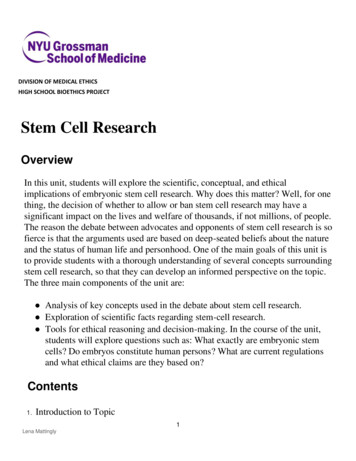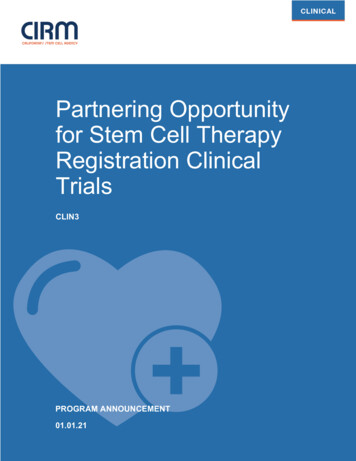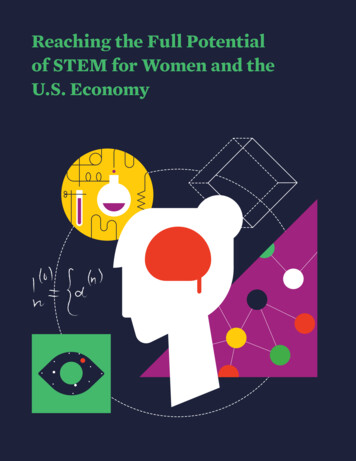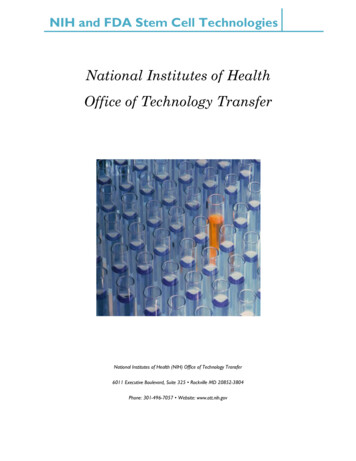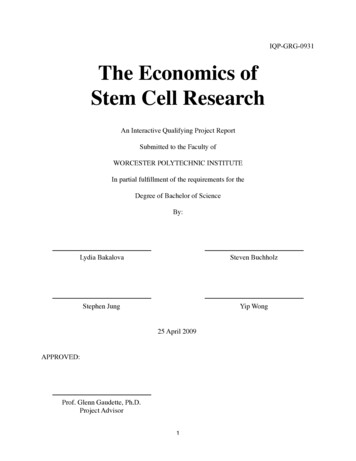
Transcription
IQP-GRG-0931The Economics ofStem Cell ResearchAn Interactive Qualifying Project ReportSubmitted to the Faculty ofWORCESTER POLYTECHNIC INSTITUTEIn partial fulfillment of the requirements for theDegree of Bachelor of ScienceBy:Lydia BakalovaSteven BuchholzStephen JungYip Wong25 April 2009APPROVED:Prof. Glenn Gaudette, Ph.D.Project Advisor1
AbstractIn 2006, Massachusetts passed the Massachusetts Life Science Initiative earmarking 1billion for the development of the life sciences, particularly in the feild of stem cells. This IQPseeks to characterize the economic climate surrounding this initiative by looking at the actionstaken by other similar initiatives taken by other states. The report will then critique the actionstaken thus far and provide a set of reccommendations for future expenditures.2
Table of ContentsTable of Figures5Table of Tables5Project Objectives6Methodology7Glossary of Abbreviations8Chapter 1: Stem Cells10Characteristics of Stem Cells10Sources of Stem Cells11Current Areas of Research16Ethics22Chapter 2: Economics24Patents24Companies25Investment Categories26Chapter 3: State Initiatives33New is44Maryland45New York46Chapter 4: Focus on Massachusetts493
Massachusetts Life Science Center49Massachusetts Life Science Initiative (MLSI)49Massachusetts Stem Cell Bank49International Stem Cell Registry50Universities51Grants52Small Company Investments53Tax Incentives54Chapter 5: Recommendations for Massachusetts57Summary57Basic Research58Universities59Small Pharmaceutical and Start-up Companies61Small Business Clusters63Large Pharmaceuticals63Collaborations of academia and 0Tax Incentives70Conclusions73References74Appendix A: List of Grants by State1Appendix B: State Restrictions for Stem Cell Research and Use412
Table of FiguresFigure 1.1: Diagram showing the progression of stem cells from the totipotent to unipotentsate detailing the extraction of ES cells.13Figure 1.2: Diagram detailing the differentiation of a hematopoietic stem cell.15Figure 3.1: Timeline of State Initiatives.34Figure 3.2: Flowchart Breaking down the distribution of funds for California Initiative.38FIgure 3.3: Distribution of state funds for New York.48Figure 4.1: Chart listing the top ten states in order of NIH funding totals and then showingfunding per biotech employee.54Figure 5.1: Table showing patents issued by state and per 100,000 people.59Figure 5.2: Chart showing state initiative spending per capita.61FIgure 5.3: Chart showing investment per capita enrolled in higher education.62Figure 5.4: Chart showing opinion poll of preparedness of graduates of varied levels.66Figure 5.5: Chart showing opinion poll of preparedness of graduates for the life sciences.69Figure 5.6: Chart showing corporate income taxes by state.71Table of TablesTable 2.1: Gerons expenses in Thousands of dollars31Table 3.1: Two Combined Economic Impacts on New Jersey37Table 3.2: Projected number of jobs created during each time period.39Table 3.3: Healthcare costs to California and projected savings40Table 5.1: Summarization of Recommendations for MLSI575
Project ObjectivesThe goals of this Interactive Qualifying Project (IQP) were to study and analyse theeconomic potential of stem cell research and application, to develop an unbiased plan for theinvestment of the 1 billion set aside by the Massachusetts Legislature for the MassachusettsLife Sciences Initiative (MLSI) and to provide the community and general public with a roadmap of the current layout of stem cell research and application. Our findings indicate that stemcell research in the United States may have been hindered by restrictions placed on thefunding of stem cell lines by the federal government. Consequently, the state governementshave put forward money in the form of initiatives in order to attract stem cell research andindustry so that the state may gain the benefits of this promising technology. The MLSI,passed in 2006, set aside 1 billion in funding for the life sciences. Part of this initiative isintended for use in stem cell research and related industry. Most research companies basedsolely on stem cell research are not making money and have partnered with pharmaceuticalcompanies to continue research. Phamaceutical companies are attracted by potential productsand treatements to be developed in the future. Although no specific products have beenmarketed, treatments, such as bone marrow transplant, which utilize the stem cells of thepatient or a specific donor have been successful. Stem cell transport has been taken up by mostbiologic transport companies which are established both nationally and internationally.Storage, however, is a growing industry that has only begun to be explored. Massachusetts hasset aside part of the MLSI to create a national stem cell bank and to create the first humanembryonic stem cell (hESC) registry.6
MethodologyThe approach to gather information and analyze the data acquired for this report was broken up into four main areas: research, interviews, company comparisons, and state comparisons.The initial research was broken up into three main categories: science, legislation, and economics. The basic science behind stem cells was researched through journals, websites, and textbooks. Legislative background was pulled from journals, websites, and public documents. Aworking understanding of economics came from journals, stocks, company profiles, and financialreports. This initial background was supplemented through interviews with politicians, life science employees, and venture capitalists.From all of this information, methods of comparing companies and states were put together. Companies were broken down into four sub-categories for easier comparison: largepharmaceuticals, small pharmaceuticals/start-up companies, research companies, and small business clusters. States were broken down into three sub-categories: legislation regarding stem cellresearch and restrictions, state initiatives with significant financial investments focused on thelife sciences, and companies located within each state.7
Glossary of Abbreviations*NameAbbreviationInteractive Qualifying ProjectIQPMassachusetts Life Science InitiativeMLSIHuman Embryonic Stem CellshESCsEmbryonic Stem CellsES cellsFetal Stem CellsFSCsAdult Stem CellsASCsUmbilical Cord Stem CellsUCSCsNational Institutes of HeatlthNIHFood and Drug AdministrationFDANeural Stem CellsNSCsUnited States Patent and Trademarks OfficeUSPTOMaterial Transfer AgreementMTAWisconsin Alumni Research FoundationWARFNew Jersey State Stem Cell InitiativeNJSCIUpdated Economic Benefits of the New Jersey Stem Cell Capital Projects andResearch Bonds ActGross Domestic ProductGDPNew Jersey Cord Blood BankNJCBBCalifornia Institute for Regenerative MedicineCIRMUniversity of WisconsinUWWisconsin Technology CouncilTech CouncilNational Stem Cell BankNSCBMedical Doctor*New JerseyReportMDUniversity of ConnecticutUConnIllinois Department of Public HealthIDPHIllinois Regenerative Medicine InstituteIRMIMaryland Technology Development CorporationTEDCOMaryland Stem Cell Research FundMSCRFInnovative, Developmental, or Exploratory ActivitiesIDEAMassachusetts Life Science CenterMLSCUniversity of Massachusetts Medical SchoolUMMSItems are listed in order of appearance in text.8
NameAbbreviationInduced Pluripotent Stem CellsiPSCsDoctor of PhilosophyPhDWorcester Polytechnic InstituteWPICalifornia State University Program for Education and Research in BiotechnologyMassachusetts Institute of TechnologyCSUPERBMIT9
Chapter 1: Stem CellsCurrently, stem cell research and related treatments hold enormous promise for the curingof debilitating diseases such as spinal cord injury, Parkinson’s disease, diabetes and many othercell-based illness. Stem cells are categorized based on defining characteristics and the sourcesfrom which they are obtained. Although not all types of stem cells are used in current research, itis important to first gain an overall understanding of the terminology used. Then, more detail canbe given to the specific stem cells used and the research currently being done.Characteristics of Stem CellsStem cells are defined by their two unique characteristics: the ability to remain undifferentiated and their level of potency. An undifferentiated cell is a cell that has not developed into aspecific cell type, such as a neuron or a red blood cell, and is capable of self-renewal. Stem cellswill retain their undifferentiated state in order to create more tissue based on the needs of the organ. This allows the cell to be programmed to develop into another specialized tissue or organ ofthe body depending on the conditions it encounters. Stem cells divide to form two cells. One iscalled a daughter cell and it remains a stem cell. The second proliferates and then differentiatesinto the type of cells needed in the surrounding environment. (Cooper, 2007) Potency refers tothe level of differentiation already undergone by the initial stem cell. Depending on the potency,a stem cell could only differentiate into a single type of cell, such as muscle stem cells, whichonly become muscle cells, or hundreds of types of cells, such as the cell that is formed from thefertilization of an egg, which will differentiate into every cell of the organism.10
There are five levels of potency: totipotent, pluripotent, multipotent, oligopotent and unipotent. Totipotent stem cells can differentiate into literally every type of cell and tissue found in theorganism. These cells are only found in embryos less than five days old. Pluripotent stem cellscan differentiate into almost every type of cell and tissue in the organism but are limited based onwhat layer of the blastocyst they are apart of. Pluripotent cells are only found in embryos five toseven days old. These cells are no longer considered totipotent because the inner cell mass, theembryoblast, cannot differentiate into cells of the placenta and the outer cell layer, the trophoblast, can only differentiate into cells of the placenta. Multipotent stem cells can differentiate intomany types of cells and tissues but only those within a closely related family of cells. For example, a hematopoietic cell, a blood stem cell, can develop into several types of blood cells but cannot develop into a muscle cell or a nerve cell. Oligopotent stem cells are even more specializedso that they can only differentiate into a few types of cells, such as vascular stem cells, whichonly differentiate into endothelial or smooth muscle cells. Unipotent stem cells can only differentiate into one type of cell or tissue. As mentioned above, muscle stem cells are considered unipotent because they only differentiate into muscle cells. (Stem Cell Information, 2001)These are the characteristics that make stem cells so promising. If the differentiation of thecells can be externally controlled, then the therapist can cause the cells to re-grow damaged tissues, such as muscles or nerves, that don’t normally regenerate after injury or in the case of certain illnesses.Sources of Stem Cells11
Stem cells are drawn from four sources: the inner cell mass of a blastocyst, the fetal andadult body, and the umbilical cord of newborns. (International Society for Stem Cell Research,2008)Stem cells originating from the inner cell mass, or embryoblast, of a blastocyst are calledembryonic stem cells (ES cells). The blastocyst is the fourth stage in development of the embryousually forming four or five days after fertilization and lasting until the sixth or seventh day. Theblastocyst is made up of between 100 and 150 cells divided into two layers, the trophoblast andthe embryoblast. The trophoblast forms the outer layer of the blastocyst and is made up of between 80 and 120 cells. This layer will eventually form the placenta. The embryoblast, consistingof 20 to 30 cells is the primary source of ES cells. (Marieb, 2007) This is done by inserting a syringe or pipet into the blastocyst and gently siphoning out the embryoblast. ES cells can also beobtained from earlier stages of embryonic development, such as at the 8-cell stage, but as thisresults in many fewer cells per extraction, this is rarely done. (Cooper, 2007) (See Figure 1.1) Ashinted at, the extraction of ES cells from the blastocyst terminates further development. The advantages and disadvantages of ES cells from a research perspective will be gone over in moredetail in the Current Areas of Research and Ethics sections as well as later in this section.Undifferentiated cells found throughout the body of the organism in tissues such as bonemarrow and skin are called fetal stem cells and adult stem cells (FSCs and ASCs) depending onthe age of the organism from which they are extracted. (International Society for Stem Cell Re-12
Figure 1.1: A diagram showing the progression of cells from a totipotent to a unipotent state detailingthe extraction of ES cells.search, 2008) FSCs are extracted from the organs and tissues of the fetus as well as fetal cordblood, baby dental pulp, and amniotic fluid. These cells are hard to distinguish from ASCs andare not used to great extent in therapeutic research and so will not be discussed further due totheir controversial source, namely aborted fetuses. However, research continues to show thatthere are differences that could lead to more distinct classification in the future. (Vaziri, 1994)Most fully differentiated cells in adult animals are no longer capable of dividing. Therefore, in13
almost every tissue of the body, ASCs are present to maintain and repair. In this capacity, ASCslast throughout the lifetime of the organism and are essential for the continued function of almostevery organ. ASCs are further classified based on the families of cells into which they develop.For example, hematopoietic stem cells give rise to all types of red blood cells, white blood cells,and platelets, whereas epidermal stem cells undergo three to six divisions, called transit amplifying, before differentiating into absorptive epithelial cells, goblet cells, and enteroendocrine cells.(Cooper, 2007) (See Figure 1.2) As ASCs are found throughout the body, they can be extractedfrom whichever tissue is the topic of study and are therefore more targeted to diseases or disorders that affect a specific organ or tissue. These applications will be discussed in more detail inthe Current Areas of Research section. Advantages and disadvantages will be discussed in moredetail later in this section.Stem cells isolated from the umbilical cord blood of newborns are simply called umbilicalcord stem cells (UCSCs). UCSCs are very similar to hematopoietic stem cells in that they fulfillthe role of replenishing the blood cells of the umbilical cord and placenta. The use of these cellsis that they are easy to extract and store providing an untainted stock from which to draw on.During the treatment of some cancers or diseases, the bone marrow is eradicated and needs to bereestablished quickly in order for the immune system to resume proper function. A stored sample14
Figure 1.2: A diagram detailing the differentiation of a hematopoietic stem cell. Source: Cooper, 2007of UCSCs from the patients umbilical cord would provide a perfect match when a donor proveshard to find. Also, stored UCSCs from an unrelated donor can be used. Very little further research is being done with these cells but they will be discussed later as pertaining to stem cellstorage.Despite the diverse sources, the majority of research that is undergoing now uses embryonic and adult stem cells. There exist advantages and disadvantages for both embryonic and adultstem cells. ES cells can develop into the three types of tissues: ectoderm, mesoderm and endoderm, which can develop into all other kinds of cells in the body. Endoderm can develop into15
pancreas, lungs, liver and other organs. Mesoderm can become blood, muscle and connectivetissue. Ectoderm can develop into neurons, sensory nodes and others. (Marieb, 2007) ASCs areless potent than ES cells, therefore their potential application in the medical field is limited to thefamily of cells to which they belong. However, since ASCs are found in almost every tissue ofthe body, specific researches could remove this limitation. Because ES cells are only found inembryos, there are fewer viable cell lines available for research whereas ASCs, although harderto extract initially, are available in any living organism and can be isolated much more readily.However, ASCs’ greatest advantage over ES cells is that they do not cause as much ethical controversy . For ES cells, the most prominent issue is that the harvesting of ES cells from fetal tissue involves the destruction of the human embryo. This issue will be discussed in much greaterdetail in the Ethics section. Because of the potency of stem cells, many physicians and researchers are striving to apply them to different treatments, including Parkinson’s disease, spinal cordinjury, myocardial disease, diabetes, hemophilia, sickle cell anemia and many other cell-relateddiseases.Current Areas of ResearchBecause of the great promise of stem cells, this being that their applications could be limitless, research involving stem cells is as vast and diverse as the cells themselves. For the sake ofbrevity, this report will focus on six of the most promising and prominent research areas, whichinclude: gene therapy, treatment of Parkinson’s disease, correction of spinal cord injuries, treatment of diabetes, therapy of myocardial diseases, and treatment of sickle cell anemia.Gene Therapy16
Only non-embryonic human stem cells have been used in the study of cell-based gene therapy but scientists have started exploring the possibility of using hESCs in such therapies.Gene therapy is a very recent and experimental way to treat human diseases. Compared totraditional drug therapies which administrate chemicals synthesized outside the body, gene therapy directs the patient’s own cells to produce and deliver a healing agent. Genetic engineering,which is the elimination or introduction of special genes to physically alter or supplement thefunction of an abnormal gene by providing a copy of a normal gene, is mainly used for threepurposes: (1) to directly repair a gene, (2) to provide a gene that gives new functions, or (3) toregulate the activity of other genes (Stem Cell Information, 2001).Currently, there are about 180 gene therapy clinical trials in the US that are cell-based and75% of these trials use human stem cells, particularly hematopoietic stem cells to deliver transgenes into patients. Transgenes are genes or genetic materials that have been transferred naturallyor by any of a number of genetic engineering techniques from one organism to another. The major reason that stem cells are used in cell-based gene therapies is because of their ability to selfrenew which may decrease or eliminate the need for repeated administrations of the gene therapy(Stem Cell Information, 2001).Of all the types of stem cells, hematopoietic stem cells are most commonly used. This isbecause they can easily be removed from the body through the blood or adult bone marrow orthe umbilical cord blood of newborns. Moreover, it is easy to identify and manipulate them in thelaboratory and then return them to patients via injection. The other advantage that hematopoieticstem cells have is their ability to migrate to many different places in the human body, especiallythe bone marrow, the liver, and the spleen, all of which can be strategic locations for localized17
delivery of therapeutic agents for disorders that are not related to the blood system such as immunodeficiency disease. (Stem Cell Information, 2001).With the development of therapeutic medicine, more and more scientists have embracedgene therapy; however, certain groups of people still hold objections to it because of the failurethat occurred in 1999. At the University of Pennsylvania’s Institute of Human Gene Therapy inPhiladelphia, a patient, Jesse Gelsinger, died from a reaction to gene therapy. He accepted theexperimental treatment that had the potential to cure his disease. Unfortunately, the experimentfailed and he was killed. After his death, the Food and Drug Administration (FDA) and NIHlaunched investigations of the University of Pennsylvania studies. Later the FDA quickly shutdown all the clinical gene transfer trials at the University of Pennsylvania. The FDA also stoppedgene therapy trials in a great number of other research institutes, started launching random inspections of 70 clinical trials, and instituted new reporting (Stem Cell Information, 2001).Since then, the number of researches on gene therapy has largely decreased because thepublic has lost confidence in it.Parkinson’s diseaseParkinson’s disease is a type of brain disorder. It manifest when certain neurons in the substantia nigra of the brain die or become impaired. These neurons normally produce dopaminewhich is a critical chemical in the brain that allows smooth and coordinated function of thebody’s muscles and movement. However, when approximately eight percent of those dopamineproducing cells are damaged, the symtoms of Parkinson’s disease start to become evident (National Parkinson Foundation, 2007).18
In the United States, Parkinson’s disease is one of the most common neurodegenerativedisorders that affect at least 500,000 people (National Institute of Neurological Disorders, 2006).Moreover, about 50,000 people are diagnosed as Parkinson’s disease annually. Therefore, eachyear a huge amount of money is invested in the related research to find out a cure for it. For various reasons, traditional treatments that focused on surgical therapy and medication failed to effectively treat this disease (National Parkinson Foundation, 2007).Stem cells offer hope to provide a potential treatment for Parkinson’s disease. Researchershave been exploring the effective way to transplant stem cells into the target positions of thebrain where dopamine is needed. They cultivate stem cells from bone marrow and program themto be similar to those dopamine-producing neurons. Because Parkinson’s Disease is caused bythe dysfunction of dopamine-producing neurons in the thalamus and nothing else, it is one of themost likely beneficiaries of stem cell research (Borthwick, 2008).Spinal cord injuryThere are over 11,000 Americans who suffer from spinal cord injury annually, mostly fromtraffic accidents. Spinal cord injuries cause the loss of ability to regenerate myelin, which is alayer that insulates nerve fibers that transmit signals from the brain, resulting in paralysis. Theeffects can be permanent since myelin cells are not able to regenerate on their own. (Society forNeuroscience, 2004)Recently, Hans Keirstead and his coworkers in Reeve-Irvine Research Center used a human ES stem cell treatment to successfully restore the insulating layer for neurons in rats afterthey had been injured for seven days. The restored functions include the recovery of certain motor skills. However, the same treatment failed to treat rats with the same injury but with a longer19
time span for about ten months. This research suggested that neural stem cells (NSCs) bring hopein the treatment for spinal cord injuries, but most possibly only be effective for a certain periodof time after the injury.DiabetesDiabetes is a disease in which the body fails to produce or properly use insulin, a hormonethat is essential to convert starches, sugar and other types of carbohydrates into energy essentialfor the human body. Currently in the United States, about 7.8% of the population is sufferingfrom diabetes (American Diabetes Association, 2009).There are two types of diabetes: in type I diabetes, the patients’ bodies fail to produce insulin and this lack of production generally results from the autoimmune destruction of pancreaticβ-cells. If patients cannot receive treatment, they can suffer from a large number of other diseases, including nerve damage, kidney damage, heart disease etc. Currently, most of the patientsrely on daily injection of insulin to maintain its level in their body or use organ transplant whichis the best way to cure it. However, the pancreas allograft transplantation is greatly limited by theinsufficient number of donations and the accompanying rejection by the host (American DiabetesAssociation, 2009).A recent study done in vitro used undifferentiated hESCs to demonstrate their differentiation into pancreatic β-cells that produce insulin in human body. Stem cell treatment offers thehope of using such cell lines in cell replacement therapy for the treatment of type I diabetes inthat it can differentiate into the essential pancreatic β-cells. However, isolating the pancreaticstem cells can be a very challenging task in that pancreas is a diverse organ consisting of multiple types of cells that function together(Ball, 2003).20
Currently, NovoCell Inc. is a company that invested on the treatment of type I diabeteswith the use of hESCs. The treatment includes the creation of insulin producing islet cells originated from human embryonic stem cells which can be transplanted into patients with type I diabetes later. The company also made success in the combination of this treatment with the cell encapsulation technique that used polyethylene glycol to cover the embryonic cell-derived isletcells and protect them from the immune system of the host. Therefore, this treatment stands outfor two major advantages over other treatments for type I diabetes: no limitation on islet cell donors because of the procedure to counter immune rejection and less cell injections is required(Pollack, 2008).Myocardial diseasesCongestive heart failure is the ineffective pumping of the heart caused by the dysfunctionof heart muscle cells that are usually caused by a heart attack, hypertension, or coronary arterydisease. Many researches have been focusing on the use of stem cells to replace the damagedheart cells and therefore restore the heart’s function. All the recent studies have shown that stemcells have great potential to treat patients who have suffered from heart attack. Therefore, thisbrings great hope to future heart attack sufferers.So far, the research using stem cells to restore damaged heart function have shown successin both rodent models and human clinical trials. At the Texas Heart Institute, fourteen dying patients with heart failure accepted stem cell treatment. Stem cells were collected from the bonemarrow of those patients and then were injected back into them later. There was another group ofpatients that did not undergo the stem cell treatment. After about two months, compared to the21
untreated group, the treated group could pump more blood and experienced less chest pain(Fischman, 2003).Sickle cell anemiaSickle cell anemia is the most common inherited blood disorder in the United States. It is adisease in which the body produces misshapen red blood cells that do not last as long as normal,round red blood cells and lead to anemia. The abnormal sickle cells pile up in the blood vessels,causing pain, anemia, infections, organ damage, and stroke. In the United States, there are approximately 80,000 people who have this inherited condition. There is no known cure other thanstem cell transplantation at current stage. (National Heart Lung and Blood Institute, 2008).Researchers at Memorial Sloan-Kettering Cancer Center devised a new way using stemcell based gene therapy that genetically reverses sickle cell anemia in the human cells. In thisgene therapy, a viral vector was introduced in cell cultures of patients with sickle cell anemia toprevent the production of the abnormal hemoglobin which is the cause of sickle cell anemia. Theresearchers found that the newly formed red blood cells produced normal hemoglobin and suppressed the production of the misshapen hemoglobin (Samakogly, 2005).Now Sickle cell disease can be cured by transplanting healthy hematopoietic stem cellsfrom a donor. However, there exists a problem for most patients: it is difficult to find a compatible donor. Hopefully this difficulty can be solved in the near future.Ethics**For a well-thought out and detailed analysis of the ethical and moral implications of all stem cell types, please see “The StemCell Controversy” by Jessica Collins (02E023I)22
With any type of research or treatment, there are always ethical implications to the actionstaken. Stem cells, and more specifically hESCs, have formed the center of ethical controversysince their derivation in 1998. The heart of this debate is made up of several central questions.The most vehement arguments tend to stem from the moral status of the human embryo itself,and whether this status necessitates that it be protected under law. Further extrapolation fromthese questions brings into question the status of newly formed hES cells.ASCs and UCSCs do not raise these same issues as they fall under the same ethical considerations as donated blood or somatic cells. FSCs raise even greater ethical controversy becauseof the debate surrounding abortion in general. When this is merged with stem cell controversies,it creates ethical dilemmas not worth pursuing.Convictions designating the moral status of the human embryo tend to follow three generaltrends. Some people believe that human life begins at the “moment of conception”, namely thepoint at which a sperm comes into contact with an egg. From a biological perspective, this is amisnomer as the genome is not fully established as a diploid until at least 24 hours after thesperm and egg merge. Another belief is that a person is gradually formed throughout the development of the embryo into a fetus designating conception as merely the first stage along this development. A third group beli
intended for use in stem cell research and related industry. Most research companies based solely on stem cell research are not making money and have partnered with pharmaceutical companies to continue research. Phamaceutical companies are attracted by potential products and treatements to be developed in the future.


